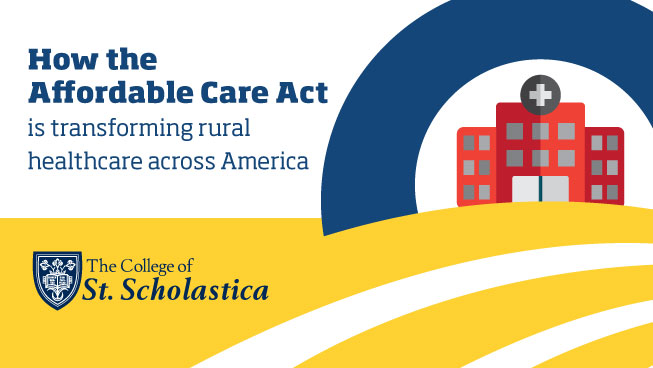October 12, 2015
How the Affordable Care Act is transforming rural healthcare across America

The conversation about rural healthcare in America has steadily gained traction since the Patient Protection and Affordable Care Act (ACA) was signed into law in March 2010. But the conversation is far from over.
The bill’s primary goals were to provide more Americans with access to affordable, high quality healthcare and simultaneously reduce the growth of healthcare spending across the country, according to the ACA website.
On the surface, the ACA is simple enough to understand — authors of the bill felt the American public was being denied access to quality, affordable healthcare services. But rural communities are being impacted in a multitude of ways that many people fail to recognize.
People living outside rural areas don’t often understand the shortage of healthcare available to those communities. Is the ACA a lifeline for rural America? Is the bill doing what it was written to do? Most importantly, is it actually helping people?
Here is what we found.
The reality of rural healthcare in America
Twenty percent of America’s population lives in rural communities — nearly 51 million people — yet only 10 percent of healthcare practices are located within these areas, according to the Kaiser Family Foundation. A quarter of the non elderly — younger than 65 — rural population lives below the federal poverty level, which translated to about $19,790 for a family of three in 2014.
A lower income makes it increasingly difficult for a rural family to afford health coverage, yet rural residents are generally less likely to receive employer-provided health benefits. Eighteen percent of non-metro residents are uninsured, and these citizens are statistically more likely to suffer longer stretches of being uninsured.
Rural residents also suffer from higher rates of chronic health conditions than those living in urban areas. And prior to the ACA, rural families paid nearly 50 percent of their healthcare costs out-of-pocket.
It has been reported that more than 50 rural and Critical Access Hospitals endured forced closures within this decade, with an additional 283 currently on the brink of locking their doors. This means that some rural residents must travel more than 40 miles to access routine or emergency medical care.
Can the Affordable Care Act answer the cries for help?
The need represented in our rural communities is clear — so what’s being done about it?
The Affordable Care Act aims to meet the needs of rural Americans through a number of initiatives, according to a statement from the White House. The goal of the ACA is threefold: lower healthcare costs, provide more healthcare options and increase the quality of care.
1. Minimize costs
The ACA eliminates all lifetime limits on how much insurance companies will cover if recipients get sick, while also banning insurers from dropping beneficiaries from coverage when they encounter serious illness or injury.
All plans that exist within the new Health Insurance Exchanges — the ACA-hosted online marketplaces that empower users to compare qualified plans — and all new plans have a cap on what the companies can require recipients to pay out-of-pocket through copays and deductibles.
Health insurance companies now need to submit justification for requested premium increases. The ACA cracks down on disproportionate insurance overhead by applying standards to how much companies can spend on non-medical costs such as executive salaries and marketing.
2. Increase accessibility & variety
Many states see a single insurance company dominate more than 80 percent of the market. This is because in addition to low rates of affordability, accessibility to alternate options has been almost nonexistent. The insurance exchanges provide numerous options for private insurance, including multistate plans. This increases consumer choice and fosters a greater level of competition among providers.
The exchanges provide the information needed to conduct side-by-side comparisons of different plans available in each geographical location. This has the potential to increase the likelihood that families will be matched with the coverage that best meets their needs.
The ACA also ensures that coverage cannot be denied to children based on preexisting conditions. Adults with preexisting conditions will also be granted access to affordable insurance through a subsidized high-risk pool, which is designed to help protect them from medical bankruptcy.
3. Improve quality of care
A crucial step in minimizing the gap between the health of non-rural and rural communities is a renewed focus on preventative care. New plans are required to cover prevention and wellness benefits at no charge to American families, effectively eliminating preventative services from copayments and deductibles. Such services include mammograms for women and routine foot, eye and blood testing for diabetics.
Tax credits have also been granted to small businesses to make employee coverage more affordable. Nearly a third of rural Americans work for small businesses, so the potential impact of these credits is enormous.
The ACA helps ensure hospitals and other care providers in remote communities receive the reimbursement needed to offer quality care to patients and keep from closing their doors. Doing so could create a steady demand for primary care physicians and other hospital personnel. Thus, the ACA includes the provision of more resources to medical schools to train physicians who will work in underserved areas.
Funding has even been expanded for financial assistance and loan reimbursement for students committing to work in underserved communities through the National Health Service Corps.
Looking toward the future of rural healthcare
The need for improvements to rural healthcare in America cannot be overstated. That is why many remain hopeful that the constructs of the ACA will continue serving those in need well into the future.
The process of serving rural communities is ongoing, but there is a lot you can be doing before you become one of those on the frontlines. Many are considering a business-centered approach.
Receive Program Info and Financial Aid Options
- Detailed program overview
- Personalized financial aid
- Individual admissions support

